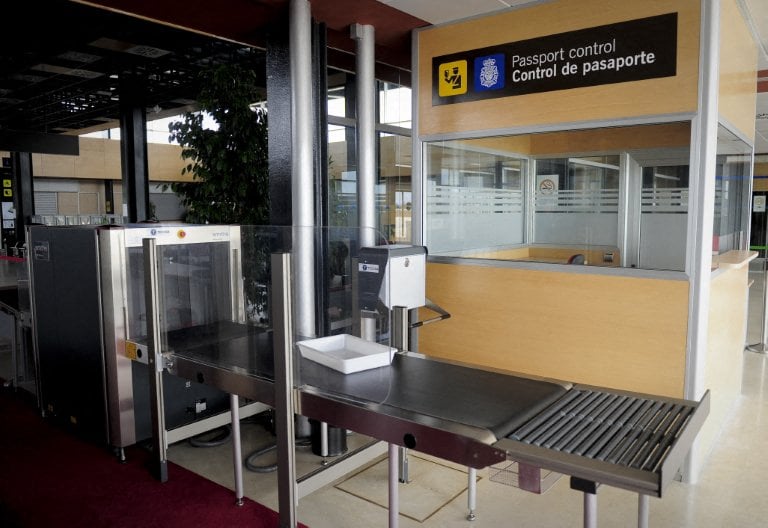Madrid Barajas, Barcelona El Prat, Palma de Mallorca, Valencia or Málaga-Costa del Sol. These are all big and well-known international airports that welcomed the bulk of the 283 million passengers that used Spanish airports in 2023.
However, the world’s second most popular holiday destination based on internet searches, is also home to several airports that nobody uses, or very few people do.
They’re known as ‘ghost airports’ (aeropuertos fantasma in Spanish) and there are several of them, some of which welcome just a handful of passengers a year.
READ ALSO: ‘Ghost’ Spanish airport welcomes its first plane…an empty one
Let’s take an example. The chances are that you haven’t heard of Huesca-Pyrenees airport, in north eastern Spain, which may well claim to be the quietest airport not only in Spain but the entire world. 178 commercial passengers used the airport in 2023 (data up until November) for an average of just one every two days.
In fact, in November 2023, just four commercial passengers set foot in Huesca airport in the entire month. And 2023 isn’t even its worst year — in 2016, 95 passengers passed through Huesca airport in the entire year, an average of 0.26 a day.
As such, Huesca-Pyrenees is now mainly used as a school for pilots and passenger cabin crew and, technically speaking, these people make up the bulk of the ‘passengers’ listed on many records.
At least 10 ghost airports
But Huesca isn’t alone. According to Aena’s official statistics, in 2023 there were several airports that barely had any commercial passengers.
Madrid’s tiny Cuatro Vientos airport had just 814 commercial passengers in 2023. Córdoba airport had just 2,419, for an average of 6.6 a day, and Burgos just 3017, for an average of 8.2 per day.
Salamanca, Logroño, Lérida, Albacete, Castellón and León also have airports that most Spaniards have neither used nor heard of.
A notable mention goes to Ciudad Real airport, also considered a ‘ghost airport’ by many because after its inauguration in 2008, it only operated for four years before closing due financial and management problems.
However, it reopened in 2019 and, like many of the passenger-less airports are forced to, currently focuses on other aviation activities such as aircraft maintenance, freight transport and private flights, among others.

Why does Spain have airports that nobody uses?
Spain’s ghost airports are intrinsically tied to the general overindulgence of pre-financial crash Spain. Billions and billions were pumped into a building extravaganza across the country in those years before the 2008 crash, with huge optimism about the future of the country backed up by European funds. Many of these airports were built then.
But it wasn’t just airports. Massive building works were also set up for hotels, apartment blocks, and infrastructure projects. Years later, with all that optimism now long gone, many of these constructions still stand, half-finished, as reminders of the excesses of that pre-crash optimism.
This time was also a period of ‘tourist boom’ when the tourism sector in Spain was growing rapidly and becoming increasingly profitable. Many local governments wanted to tap into this and invested in airports, dreaming of hitting it big in the tourism sector. Huesca airport had hopes of reaching 160,000 passengers a year, and Ciudad Real, for example, invested a whopping €1.1 billion in total.
Which brings us onto the next possible explanation. As is sometimes the case in Spain, with that much money involved and little (to no) product produced, one also has to wonder if corruption played a role. In 2014, Carlos Fabra, the man behind another of Spain’s infamous ‘ghost airport’ in Castellón, was sentenced to four years in prison on charges of tax fraud.

Another factor that’s contributed to ensuring these airports’ dire chances of survival is the competition. Simply put, many of these airports are in smaller towns and cities, and suffer from having bigger neighbours with bigger airports nearby.
The big boys of Spanish aviation on the mainland (Madrid, Barcelona, Valencia, Málaga, Valencia and Alicante) pull away a lot of the business because they have more flights available, to more destinations, more frequently, and with better surrounding infrastructure.
Often at the tinier airports, like Huesca or Burgos, the routes will be quite specific and the timetables quite fixed. Many only have two or three departures a day, and getting there can be tricky.
Furthermore, almost all are located either more rural or depopulated areas – a reflection of the broader concept of the so-called ‘Empty Spain’ (España Vaciada) – or in mid-sized cities with smaller populations, less tourism and job opportunities.
READ ALSO: How ‘Empty Spain’ is now a political party



 Please whitelist us to continue reading.
Please whitelist us to continue reading.
Member comments